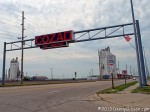
 I live a little over eight miles from Cozaddale, Ohio, and have driven through it numerous times. The most recent was June 9 when I took the first picture at right. I live a little over eight hundred miles from Cozad, Nebraska, and have driven through it exactly twice. The most recent was Friday when I took the second picture at right. As you might suspect from the names, there is more to connect these two towns than my visits. Both were named for, or more accurately by, the same man.
I live a little over eight miles from Cozaddale, Ohio, and have driven through it numerous times. The most recent was June 9 when I took the first picture at right. I live a little over eight hundred miles from Cozad, Nebraska, and have driven through it exactly twice. The most recent was Friday when I took the second picture at right. As you might suspect from the names, there is more to connect these two towns than my visits. Both were named for, or more accurately by, the same man.
John Jackson Cozad was born in 1830 near Allensville, Ohio, but he didn’t stick around long. He ran away at the age of twelve and before long found his way onto riverboats plying the Mississippi and Ohio Rivers. He also found his way into a successful career as a faro dealer. I’ve found no indication that his success came from anything other than a carefully developed ability to read the faces of opponents, but I did find a claim that this ability led to him being barred from riverboats and other gambling operations.
Although he never completely gave up cards, Cozad moved into real estate speculation/development around 1870. He laid out an eight street village on land he owned along the Marietta and Cincinnati Railroad and formed a building association. Things began well enough and a few buildings were completed in this place he called Cozaddale before some “trouble” (of which I’ve found no details) brought about the end of the association and Cozad’s development of his first town.
Horace Greeley may or may not have said “go west, young man” a few years earlier but John J Cozad probably didn’t need any such encouragement anyway. Nebraska had become a state in 1867 and, apparently while still postmaster of Cozaddale, Cozad went to look it over in 1872. The way railroad section boss John Cusack tells the story, he was checking track on a handcar headed west when he spotted Cozad, in top hat and tails, walking east. The Ohioan had been on a westbound train when he spotted a 100th meridian sign and left the train at the next stop. Inspired by the sign, Cozad developed an almost instant vision for a town that he described to Cusack. After hitching a ride on the handcar, Cozad returned to Ohio, bought 40,000 acres of Nebraska, then came back with about thirty others to build a namesake town at the 100th meridian.
Cozad, the town, grew and Cozad, the man, became a “hay tycoon”. As a big time farmer in cattle country, Cozad, the man, had his share of conflicts with ranchers. One such conflict was with an Alfred Pearson. Some reports say Pearson pulled a knife and some reports say Cozad thought Pearson reached for a knife. All reports say that Cozad pulled a gun and fired. Pearson died of his wounds a couple of months later and Cozad the man left Cozad the town almost immediately. Teresa Cozad, John’s wife, stayed around long enough to dispose of the family’s holdings then, with their two sons, she too vamoosed.
To most people, the Cozad clan seemed to have simply disappeared then, in the 1950s, a descendant revealed some of the missing bits of the story. Using the name Richard Henry Lee, John Cozad opened a place called Lee’s Pier on the boardwalk of Atlantic City, New Jersey. Son Johnny posed as a brother-in-law using the name Frank Southern and son Robert posed as a nephew or foster son named Robert Henry. Perhaps not surprisingly, Richard Lee managed to stir up things in Atlantic City, too. In a conflict with the city over selling his property, Lee/Cozad built a barricade across the boardwalk that earned his place the name “Fort Lee”. He eventually lost but it took the state legislature to beat him.
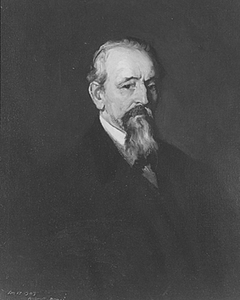 John A. Cozad, a.k.a. Frank Southern, eventually went back to his real first name and became, as Dr. John Southern, a well respected physician in Philadelphia. Robert Henry Cozad retained a slightly modified version of his Atlantic City alias and went on to great fame as an artist. His childhood home in the second town his dad founded is now the Robert Henri Museum. At left is a portrait that Robert Henri painted of his father, John J. Cozad, in 1903.
John A. Cozad, a.k.a. Frank Southern, eventually went back to his real first name and became, as Dr. John Southern, a well respected physician in Philadelphia. Robert Henry Cozad retained a slightly modified version of his Atlantic City alias and went on to great fame as an artist. His childhood home in the second town his dad founded is now the Robert Henri Museum. At left is a portrait that Robert Henri painted of his father, John J. Cozad, in 1903.
This is obviously one of those pre-written pieces but, unlike most of the My Gear and My Wheels sorts of things, this one is tied ever so slightly to real-time. I suppose it was sometime after I drove through Cozad, Nebraska, in 2009 that I discovered the connection between there and Cozaddale, Ohio. When I realized that I would be passing through Cozad again this year, I thought it might be cute to get a picture of the Cozaddale limits sign and do something with it in my journal entry when I again reached Cozad. I did a couple of searches hoping to find something interesting to say and the wild stories just kept tumbling out of the internet. It was soon apparent that it would take much more than a journal panel to do the John Cozad story anything near justice. Knowing I would be using several canned entries during the Lincoln Highway drive, I decided that this, with a single new picture, would be one of them. It was primarily constructed with information from here, here (via WayBackMachine), and here. Those three sources don’t agree on everything and there are other, slightly different, versions out there, too. That certainly doesn’t surprise me. I’ve a feeling that John J himself couldn’t get his life story completely right even if he was trying to be entirely honest and I also have a feeling that being entirely honest wouldn’t come easy to him.
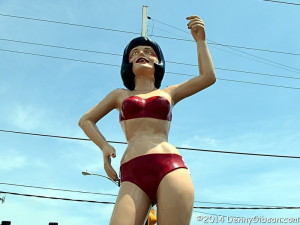 I am now en route to the 2014 Lincoln Highway Association conference in Tooele, Utah. I will eventually pick up some new-to-me LH on the way but it will take a another day to get to the planned start of the trip in Denison, Iowa.
I am now en route to the 2014 Lincoln Highway Association conference in Tooele, Utah. I will eventually pick up some new-to-me LH on the way but it will take a another day to get to the planned start of the trip in Denison, Iowa.
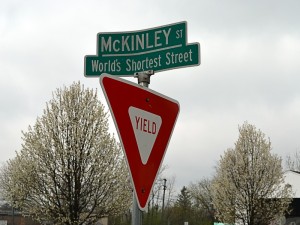
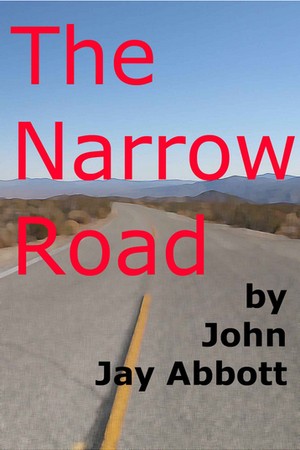 This book could be called a near opposite of the one in my most recent review. That one contained lots of information and was well researched but not so well written. The Narrow Road: An Adventure on the Lincoln Highway tells me little that’s new and involved almost no research but is fairly well written. Yes, I do have variety in my reading.
This book could be called a near opposite of the one in my most recent review. That one contained lots of information and was well researched but not so well written. The Narrow Road: An Adventure on the Lincoln Highway tells me little that’s new and involved almost no research but is fairly well written. Yes, I do have variety in my reading.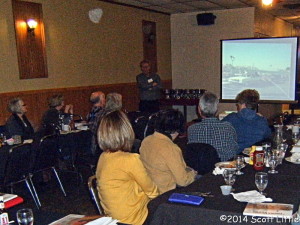

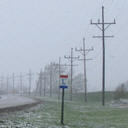

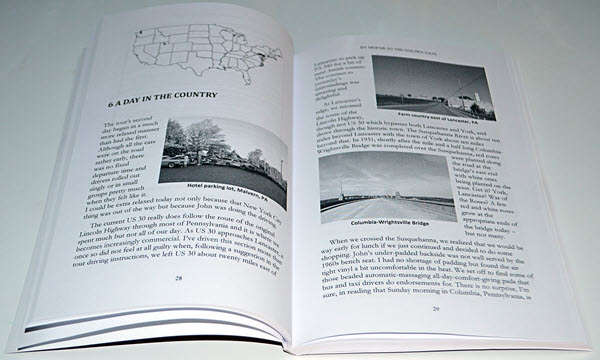
 Carl Fisher was a busy man in 1913. His Prest-O-Lite Company and his automobile dealership were both going great guns, the Indianapolis Motor Speedway he co-founded looked like it might amount to something, the Ocean-to-Ocean Rock Highway he had proposed in September of 1912 was taking off, and then there was the Indiana Automobile Manufacturers’ Association.
Carl Fisher was a busy man in 1913. His Prest-O-Lite Company and his automobile dealership were both going great guns, the Indianapolis Motor Speedway he co-founded looked like it might amount to something, the Ocean-to-Ocean Rock Highway he had proposed in September of 1912 was taking off, and then there was the Indiana Automobile Manufacturers’ Association.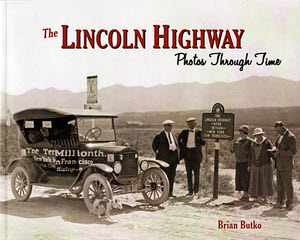 I was hesitant to post a review of this book because some of those “Photos Through Time” are mine but I decided that it would be a bad thing only if I rave about how marvelous the book is. No harm in simply describing it, right? So here are the facts.
I was hesitant to post a review of this book because some of those “Photos Through Time” are mine but I decided that it would be a bad thing only if I rave about how marvelous the book is. No harm in simply describing it, right? So here are the facts. It is organized neither geographically nor chronologically. The first section following the foreword is titled “History”. Here, among pictures of collectibles and artifacts, Butko gives a very brief history of the road’s birth and short life. It is enough to give someone who knows little or nothing about the Lincoln Highway a starting point and someone who knows everything a quick refresher on key dates and events. It is a stripped down but adequate introduction to the pictures that follow.
It is organized neither geographically nor chronologically. The first section following the foreword is titled “History”. Here, among pictures of collectibles and artifacts, Butko gives a very brief history of the road’s birth and short life. It is enough to give someone who knows little or nothing about the Lincoln Highway a starting point and someone who knows everything a quick refresher on key dates and events. It is a stripped down but adequate introduction to the pictures that follow.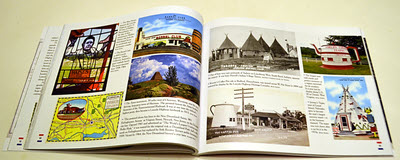 Those pictures are organized by their subjects. Butko identifies ten things that comprise the Lincoln Highway and gives each one a chapter. They are “People”, “Gas”, “Food”, “Lodging”, “Vehicles”, “Attractions”, “Signs”, “Markers”, “Bridges”, and “Roads”. The chapters are themselves samplers. Historic images from postcards and other sources are combined with modern photographs. Images of things along the road, which is every chapter other than “People”, are from locations spread over the road’s entire length.
Those pictures are organized by their subjects. Butko identifies ten things that comprise the Lincoln Highway and gives each one a chapter. They are “People”, “Gas”, “Food”, “Lodging”, “Vehicles”, “Attractions”, “Signs”, “Markers”, “Bridges”, and “Roads”. The chapters are themselves samplers. Historic images from postcards and other sources are combined with modern photographs. Images of things along the road, which is every chapter other than “People”, are from locations spread over the road’s entire length.


 John A. Cozad, a.k.a. Frank Southern, eventually went back to his real first name and became, as Dr. John Southern, a well respected physician in Philadelphia. Robert Henry Cozad retained a slightly modified version of his Atlantic City alias and went on to great fame as an artist. His childhood home in the second town his dad founded is now the
John A. Cozad, a.k.a. Frank Southern, eventually went back to his real first name and became, as Dr. John Southern, a well respected physician in Philadelphia. Robert Henry Cozad retained a slightly modified version of his Atlantic City alias and went on to great fame as an artist. His childhood home in the second town his dad founded is now the